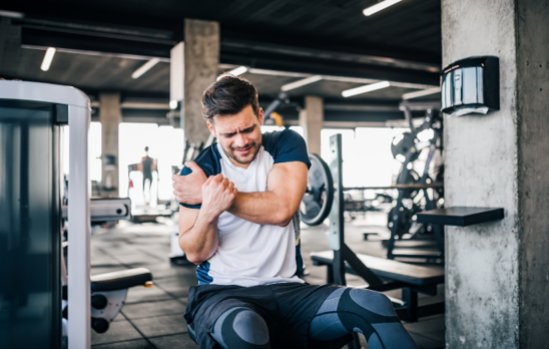Effective Biceps Tendinopathy Treatment Options

What is Biceps Tendinopathy?
Biceps tendinopathy describes a painful inflammation or degeneration of the tendon of the long head of the biceps which attaches near the top of the shoulder. The term "tendinopathy" may suggest either an inflammatory or degenerative origin. In the case of a recent acute insult, inflammation (tendinitis) may be a valid explanation. However, current evidence suggests that many cases of biceps tendinopathy occur without inflammation and are the result of chronic overload, which leads to microscopic tearing, failed healing and subsequent degenerative changes within the tendon. Injuries that have been present over three months consistently demonstrate degenerative changes with little to no inflammation.
The biceps attach to the shoulder, via two tendons. The more vulnerable longer of the two heads travels through a shallow groove on the head of the humerus (upper arm bone). It inserts itself inside the joint on the rim of the shoulder’s socket.
The action of the biceps includes forearm supination (flipping palm up), elbow flexion (bending), shoulder flexion as well as playing an important role in shoulder stability by depressing the humeral head to keep it in the center of the joint during arm elevation. Therefore, a comprehensive Biceps Tendinopathy Treatment plan must address all these aspects. Biceps tendinopathy is most common in young adults between the ages of 18 and 35. The condition often results from repetitive overhead activity, including throwing, swimming, gymnastics, martial arts, racquet sports, and contact sports. Other biomechanical risk factors for the development of biceps tendinopathy include repetitive shoulder or elbow flexion, repetitive overhead activity, improper lifting technique, shoulder muscle imbalances, poor posture, inflexibility, scapular of shoulder instability, trauma, and anatomical abnormalities including fracture, osteoarthritis, and congenital variations. Smoking is a known risk factor for biceps tendinopathy.
Subacromial impingement is the most common cause of shoulder complaints and may lead to a plethora of problems, including biceps tendinitis. In fact, 95% of biceps tendinopathy patients have "shoulder impingement" as their primary diagnosis. Biceps Tendinopathy Treatment is a crucial aspect that needs to be considered when dealing with shoulder impingement related pathologies. Because of common etiologies, biceps tendinopathy rarely occurs in isolation and >90% co-exist with other impingement related pathologies of the shoulder, including rotator cuff tendinopathy/tears, labral tears, and shoulder instability.
What Does Biceps Tendinopathy Look and Feel Like?
Patients with biceps tendinopathy often complain of a deep throbbing ache over the front of the shoulder. The pain may refer to the side of the shoulder muscles and less frequently toward the elbow or hand. Symptoms are often provoked by repetitive overhead activity and movements that require forearm rotation, shoulder flexion, or elbow flexion. Symptoms increase when initiating activity. Symptoms at night are common, particularly when sleeping on the affected shoulder. Patients often report mild relief from palliative measures including heat, ice, stretching, and massage.
More seriously, complete tendon rupture is suggested by a history of a painful audible pop followed by relief. Biceps tendinopathy will often be associated with swelling and a muscular deformity in the center of the biceps as the muscle releases towards the center of the muscle belly.
How Do We Treat Biceps Tendinopathy?
Conservative care is the most appropriate management for the majority of biceps tendinopathy patients. Traditional measures include rest, ice, activity modification, and functional re-training. The first phase of biceps tendinopathy treatment is directed at pain relief and restoration of normal motion. Patients should limit activities that require repetitive overhead activity, elbow flexion, or forearm supination. Patients should specifically avoid overhead presses, upright rows, and wide-grip bench presses. Therapeutic modalities, including ice, heat, ultrasound, microcurrent, or e-stim may be appropriate to control symptoms as needed. Smoking cessation should be encouraged since smoking impairs neovascularization in biceps tendinopathy patients.
Next, the goal of rehab should be to establish a full, balanced, pain-free range of motion. Soft tissue techniques, myofascial release and stretching exercises may be appropriate for surrounding structures to decrease stress at the injured tissues. Then, early phase of strengthening includes shoulder blade stabilization exercises. As patients recover, progressive strength training and finally, sports specific rehab will be initiated.
Medical management of biceps tendinopathy may include NSAIDs. Ultrasound-guided, local anesthetic injection into the biceps tendon sheath may provide palliative relief for patients with primary biceps tendinitis, although injections directly into the tendon may increase the risk of rupture.
Surgery is generally not considered for biceps tendinopathy unless prolonged (greater than three months) conservative measures have failed. Even in cases of tendon rupture, the value of surgery is questionable. Patients with complete rupture of the long head of the biceps tendon only demonstrate 11-16% diminished strength in the arm. Surgical repair (tenodesis) is usually reserved for younger individuals (<60), athletes, and manual workers.
If you have been suffering with biceps pain or shoulder pain, schedule an appointment today to see how our doctors can help with biceps tendinopathy treatment!
